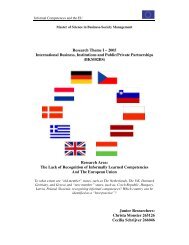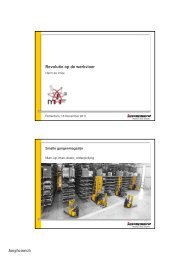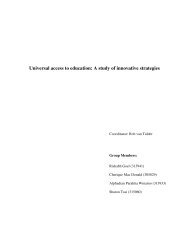here - ERIM - Erasmus Universiteit Rotterdam
here - ERIM - Erasmus Universiteit Rotterdam
here - ERIM - Erasmus Universiteit Rotterdam
Create successful ePaper yourself
Turn your PDF publications into a flip-book with our unique Google optimized e-Paper software.
A validation Study of House of Quality key performance indicators<br />
Communities of interest; members of this type of communities are willing to share<br />
knowledge and experiences. For example recommendation sites like Kieskeurig.nl, w<strong>here</strong><br />
people share their experiences about different product.<br />
Communities of fantasy; within communities of fantasy members interact with each other by<br />
playing virtual games with each other. Within this fantasy world members can play with<br />
fictive persons in different fictive environments.<br />
Communities of transaction; within this communities members exchange goods, services etc.<br />
on a demand and supply manner.<br />
Although this classification by Hagel and Armstrong (1997) is still used, nowadays many other types<br />
of virtual communities can be distinguished. Some examples are; brand communities (Muniz &<br />
O’Guinn, 2001), communities of ethnicity (Mitra, 1999), communities of consumption (Kozinets,<br />
1999) and e-learning communities (Hardaker and Smith, 2002). Although these types of virtual<br />
communities are useful to detail and will limit the focus for research, according to De Valck (2005)<br />
they do not add new categories to the classification of Hagel and Armstrong (1997).<br />
De Valck (2005) stated that in fact most virtual communities are a combination of a community of<br />
relationships and a community of interest which combines social interaction with information<br />
exchange based on for example a similar demographic background, specific brand, consumption<br />
related activity, certain travel destination or a medical problem.<br />
To cover the main purpose served by virtual communities, De Valck (2005) adds another type to the<br />
four types distinguished by Hagel and Armstrong (1997); the community of practice. A community of<br />
practise consists of a group of people who are informally bound (within or between organizations)<br />
and share their knowledge and information to learn from each other regarding shared (work) related<br />
practices.<br />
Segmentation by computer mediated context<br />
Virtual communities are supported by different functional software systems, like for example; email<br />
lists, chat rooms, electronic bulletin boards or online buying functionalities. Different types of virtual<br />
communities will arise due to different characteristics of the software (De Valck, 2005). Kozinets<br />
(1999) classified virtual communities, based on the computer mediated context of the community.<br />
This classification is based on two dimensions; group focus (information exchange vs. social<br />
interaction) and social structure (loose vs. tight).<br />
30
















